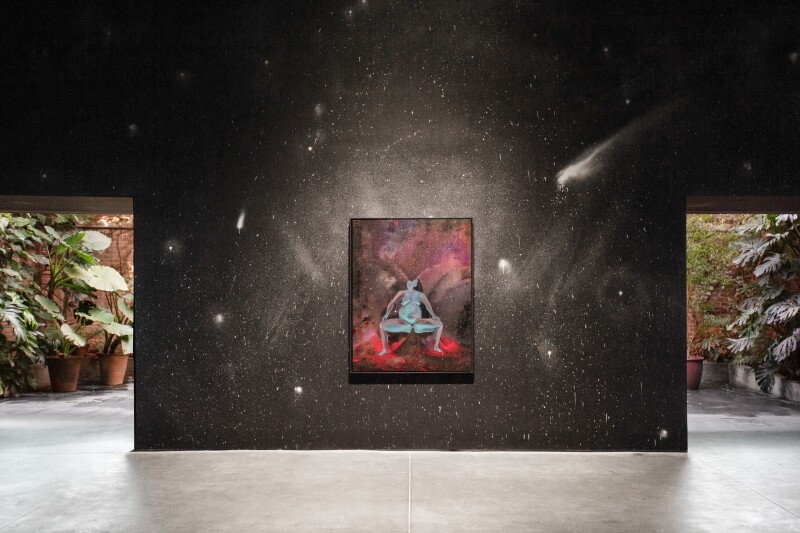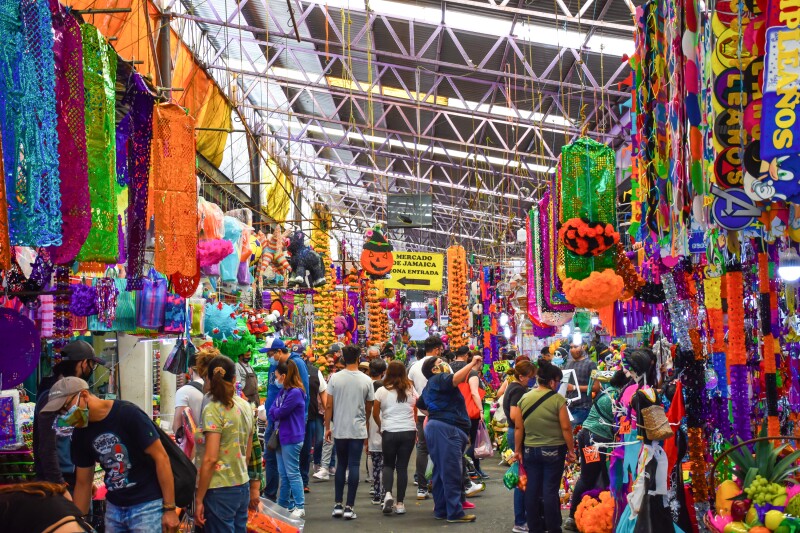With a booming art and food scene, Mexico City has been luring travelers from around the globe for years. This influx of visitors has meant a more diverse line-up of places to select from, but it’s also becoming increasingly hard to eke out destinations where people aren’t snapping selfies. “My advice is wherever you see locals and smell charcoal mixed with toasted corn, stop for some tacos with a cold Michelada,” says Domitila Bedel, director of Fueguia, a perfume laboratory with a store in Mexico City. Here, several locals give their favorite picks for a long weekend in Mexico’s bustling capital.
Day One: Linger for a long lunch
On arrival, grab an Uber at the airport and head straight to Contramar for lunch. (Ubers are relatively affordable and easily available throughout the city.) “You can’t leave this city without having the atún (tuna) tostadas from Contramar,” says Bedel. The restaurant, founded by chef Gabriela Camara, has a buzzy dining room filled with tables that spill onto the sidewalk. Although the restaurant is hardly close to the ocean, it evokes lazy lunches by the sea with a menu filled with ceviches, tostadas layered with tuna, and a whole butterflied fish with two sauces: red adobo and parsley. Order a few dishes to share, then finish your meal with an espresso or slice of fig tart from the desert trolley. If you’re still in the mood for something sweet, stroll over to the Roma neighborhood and join locals enjoying afternoon treats at Panadería Rosetta, a famous bakery founded by chef Elena Reygadas. Bedel recommends the guava bread.
Next, hop in an Uber and head to Casa Luis Barragán, the former residence of architect Luis Barragán, set in a midcentury-modern house filled with his ’50s furniture. Tickets are difficult to procure, so book weeks or even months in advance. By this time you might have worked up an appetite, so take another rideshare to Mi Compa Chava, a seafood-focused restaurant known for its ceviches and tostadas topped with a tower of fish, shrimp, and avocado. It’s loved by Matteo Zega, an Italy-born chef and partner at Piazza Pasticcio, a new restaurant in the Juarez neighborhood where they hand roll ravioli and tagliatella. “When my family visits Mexico, this is the first place I want to take them to,” says Zega. “For me, it sums up the feeling of Mexico: beers, good friends, and great food.” Zega usually orders the tuna tostadas, fried fish, green aguachile, and a clamato prepared with shrimp.

The National Museum of Anthropology is open on Tuesday to Sundays from 9 a.m. to 5 p.m.
Photo by quiggyt4/Shutterstock
Day Two: Culture in the park
Start your day with a wander through Chapultepec Park on the edge of Polanco, the largest park in Mexico City, filled with gardens, fountains, and lakes. “Sección 1 is the most popular part of the park, and there’s truly a reason for it—it’s beautiful, especially during jacaranda season,” says Fabiola Escobosa, chef and founder of Cana, a Mexican American bistro, in the Juarez neighborhood. She loves to rent a boat on the lake. Then, stop by LAGO/ALGO, a cultural space set in a striking modernist building designed by Alfonso Ramírez Ponce within the park. Georgina Pounds, director of the contemporary OMR Gallery in Roma, suggests you walk around the exhibitions (which are always evolving) plus the permanent one by James Turrell.
Enjoy breakfast in the glass-fronted restaurant that overlooks the lake. “Order a pot of fresh ginger tea with the farro risotto with mushrooms and poached egg,” says Pounds. Not far from here is the National Museum of Anthropology, which holds the world’s largest collection of ancient Mexican artifacts, set in a striking building on the edge of the park. “Nowhere in the world is there a museum of anthropology as beautiful as Mexico’s,” says Bedel. There are multiple rooms showcasing artifacts from the Aztecs to the Mayans, so set aside ample time to explore.

Ticuchi restaurant, with “the best drinks in town,” is open from Monday to Saturday until 11.30 p.m.
Courtesy of Ticuchi
Next, head to Polanco, the city’s version of Fifth Avenue, for lunch. Roberta Maceda, a fashion designer and founder of the minimalist, Japanese-style Octavia Casa hotel in Condesa, loves Siembra Taquería. It’s known for its fresh approach to traditional Mexican street food. “The menu highlights organic produce, ethically sourced meats, and handmade tortillas, creating a modern yet authentic taquería experience in a vibrant, casual setting,” Maceda says. “I’m a huge taco fan and I honestly think these are the best in the city for now.” In the same area is the Museo Jumex, a contemporary museum with pieces by Damien Hirst and Andy Warhol.
Afterwards, stroll over to Ticuchi, a mezcal bar and restaurant set in a dark, moody space, for drinks and a light dinner. Isabela Castillo, founder of much-loved restaurants Café Milou and Hugo in Mexico City, loves to sit at the bar and order the tamal de esquites (sweet corn tamales). “Ticuchi has the best drinks in town,” says Castillo. Opt for a zingy cocktail or sip some mezcal by lesser-known, high-quality producers.

The OMR gallery displays work from contemporary artists, including Mexico City–based Pia Camil.
Photo by Alum Galvez
Day Three: Explore art and design
Start with breakfast (if it’s a weekday) or brunch (if it’s a weekend) at Lalo, a restaurant in a long narrow room with colorful murals in Roma Norte. It’s one of Castillo’s favorites. “The scrambled eggs with escamoles at Lalo are one of the dishes I crave frequently,” she says. The Roma Norte neighborhood is arguably the city’s hippest, teeming with galleries and shops. It’s extremely walkable too. Head to the showroom run by Txt.Ure and Perla Valtierra on the edge of the neighborhood, which showcases woven furniture (by Txt.Ure) and handmade ceramics (by Valtierra). Not far from here is OMR, one of the city’s most prestigious contemporary galleries set in a white-box space.
Pounds also recommends the JO-HS Gallery, which she calls “one of Mexico’s most beautiful galleries.” Shops abound here. “Don’t miss showrooms of independent designers like Korimi (my all-time favorite), Mundo Varon, Banzo, Avec,” says Bedel, adding that the Fueguia store is in the same building as Casa Bosques, a bright and airy bookstore. Maceda also suggests you pop into Metate. “It’s a specialty store dedicated to showcasing high-quality Mexican artisanal products,” she says. “It’s . . . a favorite for authentic, sustainable souvenirs or unique home decor.”

Sundays in Mexico City begin with a browse at one of the city’s many markets.
Photo by Eve Orea/Shutterstock
Day Four: A lazy weekend like the locals
If it’s a Sunday, do as many Mexicans do and head to the market. “I start my week on Sundays shopping at Mercado el 100,” says Castillo, who likes to pick up organic eggs and blue corn tortillas. From there she usually heads to Mercado Jamaica, on the eastern edge of the city, to stock up on fruit and flowers for her house and restaurants. “While I’m there I like to grab a tinga quesadilla at Quesadillas La Chaparrita,” says Castillo. “Strolling through markets is my ultimate relaxation and this one is a special one for me.”
Next up: make your way to the Anahuacalli Museum, a shrine created for the work by legendary artist Diego Riviera, on the outskirts of the city. “Anahuacalli isn’t just a museum; it’s a celebration of Mexican identity,” says Maceda. “Riviera’s goal was to create a space that connected the past to the present"; originally, it housed Riviera’s extensive collection of pre-Hispanic art. Wander around the nearby area of Coyoacan, filled with cobblestone streets and colorful plazas that suggest a small town. If you have a ticket (must be purchased in advance), pop into the Frida Kahlo museum, or swing by the bustling Coyoacan market, where people peddle baskets and more.
On your way back into the city, stop by San Angel Inn, a classic restaurant housed in a former monastery, with a lively courtyard. Have a martini or margarita before heading to Hugo for dinner. “Hugo is a great wine bar in Roma that specializes in natural, biodynamic, and skin contact wines,” says Andrés Saavedra, architect and cofounder of Musa, a hotel and collection of luxury properties on Mexico’s southerwestern coast.

Casa Palonco is in the heart of Mexico City, walking distance from many attractions.
Courtesy of Casa Palonco
Where to stay
Among the city’s many openings in the past few years, Hotel San Fernando, Casa Pani and Círculo Mexicano are in our Mexico City hotel guide. To splash out, opt for Casa Polanco, set in a refurbished mansion opposite a leafy park in Polanco. For food lovers, Enrique Olvera has Casa Teo and Casa Teo 2, two apartments in the same building with pieces picked out by one of Mexico City’s most renowned chefs. For something more low-key, Octavia Casa offers slick minimalist, wood-clad rooms, not far from Chapultepec Park. Casona Roma Norte is a swank new hotel with paneled walls and a lobby filled with curved couches, set in a pink mansion.











